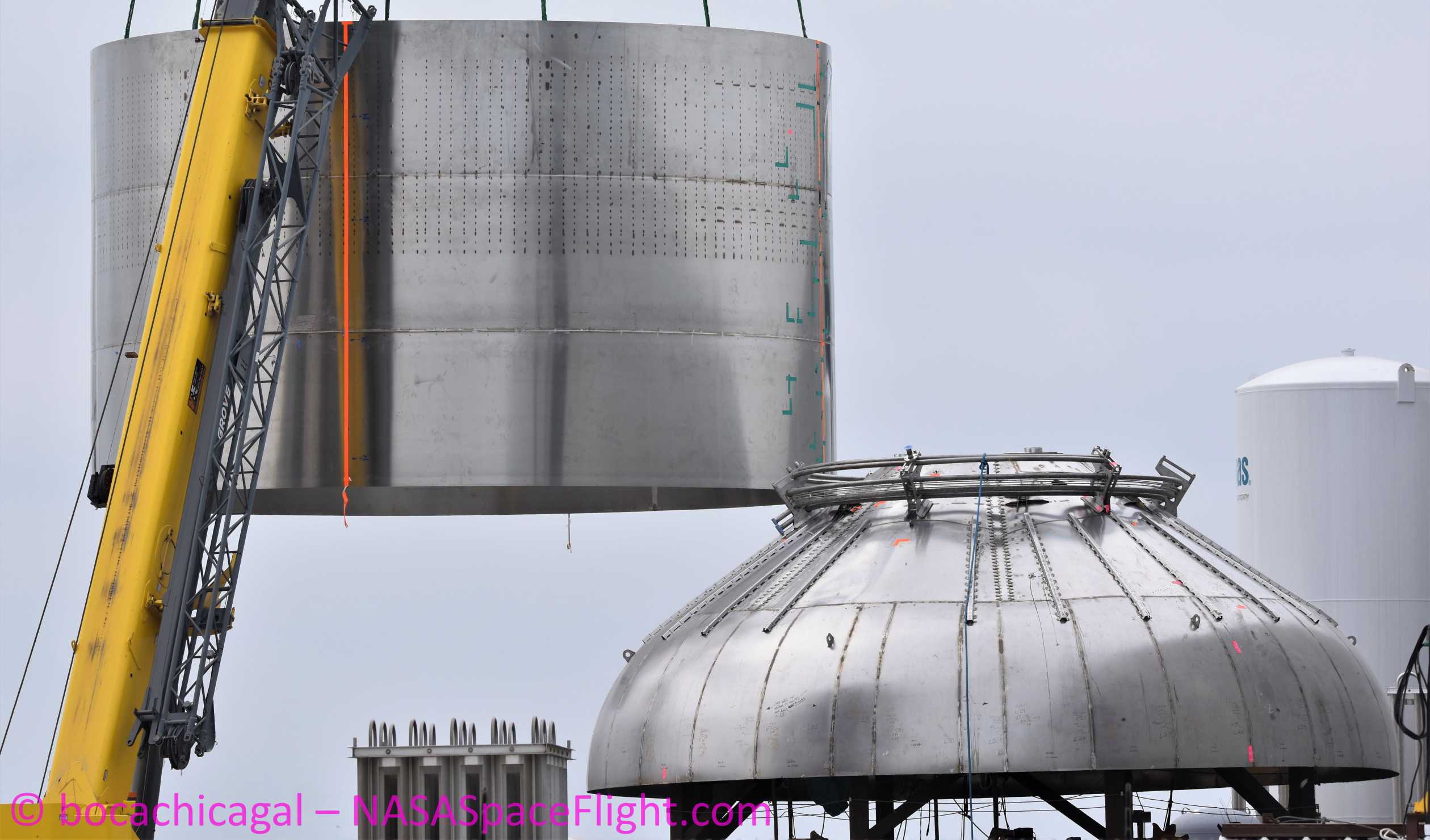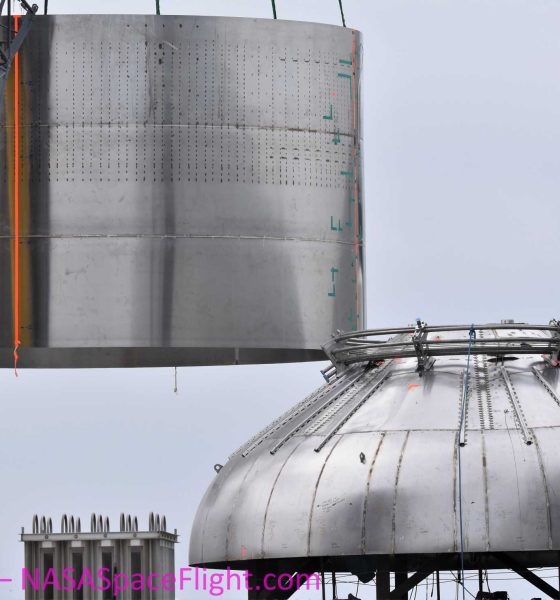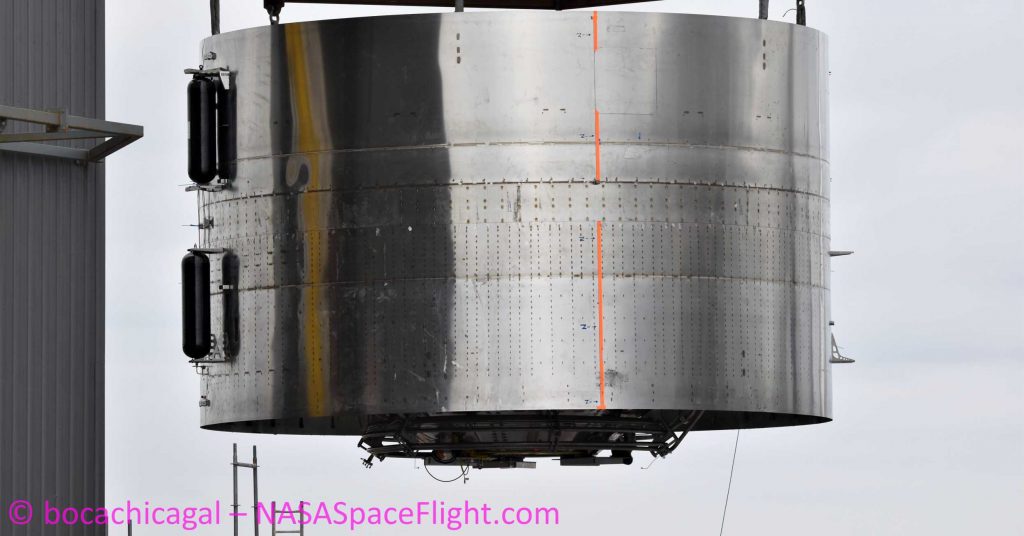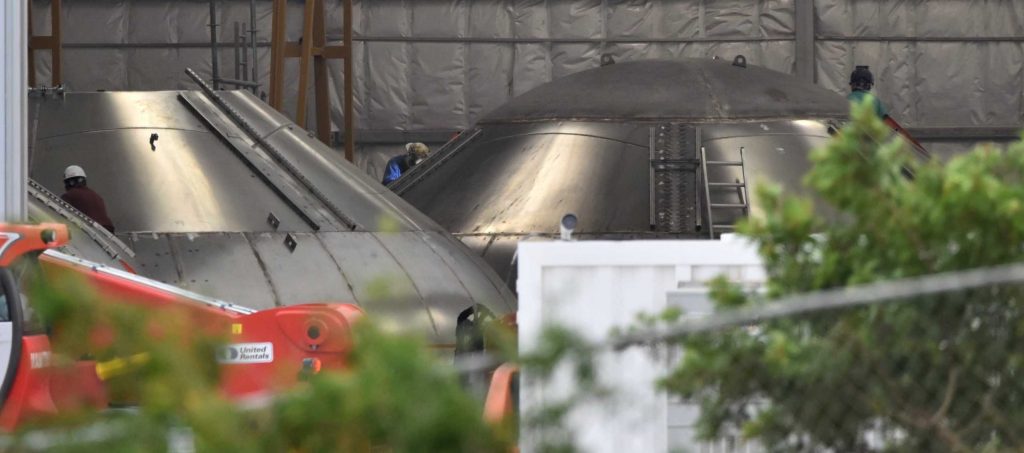

News
SpaceX Starship factory speeding towards Elon Musk’s production goals
SpaceX appears to have entered the final stages of assembly of its fourth full-scale Starship prototype with a fifth ship already close on its heels, suggesting that the South Texas rocket factory may be close to achieving CEO Elon Musk’s lofty production goals just weeks after he set them.
Known as SN4, short for the fourth serial production vehicle, SpaceX continues to build full-scale rocket prototypes – following Starship SN1, SN2, and SN3 – in a matter of weeks. While both SN1 and SN3 were destroyed during their first major tests on February 29th and April 3rd, the almost unbelievable speed of SpaceX’s Starship production suggests that each prototype is being built for pennies on the dollar compared to any traditional aerospace effort.
That speed also means that any single failure should cause no more than a few weeks of delays, assuming the failure mode can be quickly identified and rectified. Along those lines, at the same time as Starship SN4 is likely no more than a day or two away from its final stacking milestone, numerous large parts for the next prototype – Starship SN5 – have also been spotted in the late stages of fabrication. This is great news for the next few weeks of Starship development.

In simple terms, the appearance of multiple partially-completed Starship SN5 parts suggests that even if Starship SN4 soon follows in the footsteps of its predecessors and fails in the early stages of testing, another ship should be ready to take its place just a few weeks later. This has been SpaceX’s strategy for the last several months. Less than nine days after Starship SN1 was destroyed during testing, Starship SN2 – turned into a dedicated test tank instead of a full ship – successfully passed tests confirming that the flaw that destroyed SN1 had already been fixed.
Less than three weeks after SN2’s successful test campaign, SpaceX wrapped up Starship SN3 assembly and rolled the building-sized rocket to the launch pad on March 29th, five days before it failed during its second cryogenic proof test.


At its current rate of assembly, Starship SN4 should also be ready to head to the launch pad less than three weeks after SN3 was lost during testing and should be physically complete within a matter of days. By all appearances, Starship SN5 is currently where SN4 was around the end of March, suggesting that SN5 is just two weeks behind its older sibling.
As of April 15th, SpaceX teams are working to stack Starship SN4’s engine section atop a final pair of rings known as the rocket’s skirt. Possibly reused from the late Starship SN3 prototype, once SpaceX has fully assembled the engine section and skirt, one final stack will be needed to complete the rocket’s tank section.

Ultimately, it appears that SpaceX – less than five prototypes into a wholly new production line – is already close to build a Starship every other week, while Musk’s near-term goal is to complete one every week by the end of 2020. At the same time, Starship SN4 is likely just a handful of days away from being transported to the launch pad for its first test campaign.

News
Tesla starts showing how FSD will change lives in Europe
Local officials tested the system on narrow country roads and were impressed by FSD’s smooth, human-like driving, with some calling the service a game-changer for everyday life in areas that are far from urban centers.

Tesla has launched Europe’s first public shuttle service using Full Self-Driving (Supervised) in the rural Eifelkreis Bitburg-Prüm region of Germany, demonstrating how the technology can restore independence and mobility for people who struggle with limited transport options.
Local officials tested the system on narrow country roads and were impressed by FSD’s smooth, human-like driving, with some calling the service a game-changer for everyday life in areas that are far from urban centers.
Officials see real impact on rural residents
Arzfeld Mayor Johannes Kuhl and District Administrator Andreas Kruppert personally tested the Tesla shuttle service. This allowed them to see just how well FSD navigated winding lanes and rural roads confidently. Kruppert said, “Autonomous driving sounds like science fiction to many, but we simply see here that it works totally well in rural regions too.” Kuhl, for his part, also noted that FSD “feels like a very experienced driver.”
The pilot complements the area’s “Citizen Bus” program, which provides on-demand rides for elderly residents who can no longer drive themselves. Tesla Europe shared a video of a demonstration of the service, highlighting how FSD gives people their freedom back, even in places where public transport is not as prevalent.
What the Ministry for Economic Affairs and Transport says
Rhineland-Palatinate’s Minister Daniela Schmitt supported the project, praising the collaboration that made this “first of its kind in Europe” possible. As per the ministry, the rural rollout for the service shows FSD’s potential beyond major cities, and it delivers tangible benefits like grocery runs, doctor visits, and social connections for isolated residents.
“Reliable and flexible mobility is especially vital in rural areas. With the launch of a shuttle service using self-driving vehicles (FSD supervised) by Tesla in the Eifelkreis Bitburg-Prüm, an innovative pilot project is now getting underway that complements local community bus services. It is the first project of its kind in Europe.
“The result is a real gain for rural mobility: greater accessibility, more flexibility and tangible benefits for everyday life. A strong signal for innovation, cooperation and future-oriented mobility beyond urban centers,” the ministry wrote in a LinkedIn post.
News
Tesla China quietly posts Robotaxi-related job listing
Tesla China is currently seeking a Low Voltage Electrical Engineer to work on circuit board design for the company’s autonomous vehicles.

Tesla has posted a new job listing in Shanghai explicitly tied to its Robotaxi program, fueling speculation that the company is preparing to launch its dedicated autonomous ride-hailing service in China.
As noted in the listing, Tesla China is currently seeking a Low Voltage Electrical Engineer to work on circuit board design for the company’s autonomous vehicles.
Robotaxi-specific role
The listing, which was shared on social media platform X by industry watcher @tslaming, suggested that Tesla China is looking to fill the role urgently. The job listing itself specifically mentions that the person hired for the role will be working on the Low Voltage Hardware team, which would design the circuit boards that would serve as the nervous system of the Robotaxi.
Key tasks for the role, as indicated in the job listing, include collaboration with PCB layout, firmware, mechanical, program management, and validation teams, among other responsibilities. The role is based in Shanghai.
China Robotaxi launch
China represents a massive potential market for robotaxis, with its dense urban centers and supportive policies in select cities. Tesla has limited permission to roll out FSD in the country, though despite this, its vehicles have been hailed as among the best in the market when it comes to autonomous features. So far, at least, it appears that China supports Tesla’s FSD and Robotaxi rollout.
This was hinted at in November, when Tesla brought the Cybercab to the 8th China International Import Expo (CIIE) in Shanghai, marking the first time that the autonomous two-seater was brought to the Asia-Pacific region. The vehicle, despite not having a release date in China, received a significant amount of interest among the event’s attendees.
Elon Musk
Elon Musk and Tesla AI Director share insights after empty driver seat Robotaxi rides
The executives’ unoccupied tests hint at the rapid progress of Tesla’s unsupervised Robotaxi efforts.

Tesla CEO Elon Musk and AI Director Ashok Elluswamy celebrated Christmas Eve by sharing personal experiences with Robotaxi vehicles that had no safety monitor or occupant in the driver’s seat. Musk described the system’s “perfect driving” around Austin, while Elluswamy posted video from the back seat, calling it “an amazing experience.”
The executives’ unoccupied tests hint at the rapid progress of Tesla’s unsupervised Robotaxi efforts.
Elon and Ashok’s firsthand Robotaxi insights
Prior to Musk and the Tesla AI Director’s posts, sightings of unmanned Teslas navigating public roads were widely shared on social media. One such vehicle was spotted in Austin, Texas, which Elon Musk acknowleged by stating that “Testing is underway with no occupants in the car.”
Based on his Christmas Eve post, Musk seemed to have tested an unmanned Tesla himself. “A Tesla with no safety monitor in the car and me sitting in the passenger seat took me all around Austin on Sunday with perfect driving,” Musk wrote in his post.
Elluswamy responded with a 2-minute video showing himself in the rear of an unmanned Tesla. The video featured the vehicle’s empty front seats, as well as its smooth handling through real-world traffic. He captioned his video with the words, “It’s an amazing experience!”
Towards Unsupervised operations
During an xAI Hackathon earlier this month, Elon Musk mentioned that Tesla owed be removing Safety Monitors from its Robotaxis in Austin in just three weeks. “Unsupervised is pretty much solved at this point. So there will be Tesla Robotaxis operating in Austin with no one in them. Not even anyone in the passenger seat in about three weeks,” he said. Musk echoed similar estimates at the 2025 Annual Shareholder Meeting and the Q3 2025 earnings call.
Considering the insights that were posted Musk and Elluswamy, it does appear that Tesla is working hard towards operating its Robotaxis with no safety monitors. This is quite impressive considering that the service was launched just earlier this year.








